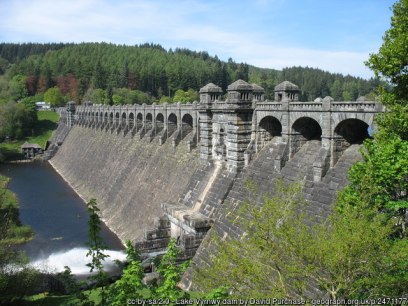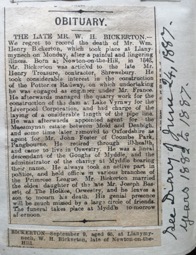

Thomas was regularly leading field expeditions for local natural history societies, particularly the Chester Society for Natural Science. He offered expert knowledge on both geology and botany, but no doubt commented on birds as well, as this was another of his studies. His reputation as an expedition guide was obviously growing, and in 1887 he was approached by the most distant group yet, and set out to plan a comprehensive programme for late June of that year which would involve the Palé family, as the Robertsons were to offer tea and a tour of the Palé gardens led by Thomas as part of the programme.
Saturday the 21st [May 1887] Mr Wilkins, solicitor, Uttoxeter, came to see me so as to make arrangements for a visit of the North Staffordshire field club to visit Bala, etc. He wanted me to be their guide, and to make out a programme for him. He had tea with us, and we enjoyed his visit very much. I met him at the station and saw him off by last train to the Lion, Bala, to make arrangements for the excursion.
By chance or arrangement, Frances Ruddy and the small children visited their Grandmother, Frances Williams, in London at the time of the expedition, thus a letter to Frances describing the expedition is also preserved amongst the pages of the journal.
The North Staffordshire Field Club visit Day 1
Thursday the 23rd The members of the North Staffordshire Field Club came to see my fossils, and to see over the gardens. I had a telegram at 4 o’clock from Bala to say a start would be made for Palé at 4:40. At 5:15, seven work and it’s full of ladies and gentlemen arrived (41 in all) .
My friend Mr Wilkins who sent me the telegram from Bala soon came to me and after introducing me to some of the leading members, Such as the President, Dr Arlidge and the Secretary the Rev Thos W Daltrey of Madeley Vicarage Newcastle Staffs. I took them through the upper garden, and pointed out my hardy ferns and interesting plants. We crossed the road and went to the lawn in front of the dining room where Mr and Mrs Robertson and family were in waiting to receive the party. After I introduced the leader (Mr Wilkins) President, & Secretary, they were all asked to partake of tea and other refreshments in the dining room, and act which was highly appreciated. The young ladies attended to their wants, and Mr Robertson and his son were most attentive and kind to them. Mrs. Robertson being an invalid could do nothing but chat to them.
They went round the grounds, so the so-called cromlech, the tumulus in the park, and as I had my fossils arranged in the front room etc. I had the most interesting plants of our district also ready for their inspection. My fossils rather took them by surprise, although their programme called it “most extensive and unique collection “. The plants pleased and very much, and they freely took specimens with them. My collection of birds’ eggs was also examined with much interest, and my ancient weapons too came in for close inspection. Mr Harry Robertson kindly assisted me to show the collections. A vote of thanks was given to Mr Robertson, and the party left at 7:40, highly pleased.
The involvement of the whole Robertson family in this visit is quite remarkable, and demonstrates the close relationship and trust between the family and their Head Gardener.
The North Staffordshire Field Club visit Day 2
The main objective of the party’s second day was the site of the construction of the reservoir to be known as Lake Vyrnwy, involving the inundation of the village of Llanwddyn. They were joined by some members of the Chester Society for Natural Science. Thomas had previously visited the site and made himself known to the construction manager, Mr. Bickerton.

A very clear series of photographs of the construction of the dam which well illustrate Thomas’ description can be found here:
https://www.lake-vyrnwy.com/history.html
It is notable that included in the visit was Professor Thomas McKenny Hughes of Cambridge, Thomas’ mentor in his practical research of the Bala fossils. Professor Hughes had connections with both the Chester Society for Natural Science and the North Staffordshire Field Club, and had probably recommended Thomas as guide for the expedition.
Also of interest is the inclusion of a number of ladies, mainly the wives of members, in the expedition. We can imagine these ladies, clad in voluminous long skirts and laced boots, and wearing hats (as shown in photos of the era) gamely clambering over the enormous construction site.
Friday, June 24 Having to act as one of the guides or leaders to the members of the North Staffordshire Field Club and over 50 of the members of the Chester Society of Natural Science, I left here by the 9.10 train. I met with the Chester folks at our station, and got into a carriage with Mr Siddall, Mr Shepheard, Mr Newstead, Mr Lucas et cetera. At Bala I had a chat with Mr and Mrs. George Dixon (Mayor and Mayoress of Chester last year) Mr Shone, Prof. Hughes and Mrs. Hughes, and several others of my Chester friends. Prof Hughes was to act as Guide with me.
I went in the same carriage as Mr Wilkins, Dr. Arledge, Rev. T.W. Daltrey, and Miss Ashdown. It was very warm and dusty most of the way, but all of the party enjoyed their ride, and were delighted with the scenery along the route. There was not much time for geology, but we found several interesting plants; the most interesting to me what’s the Geranium sylvaticumin full bloom. Mr. Siddall has botanised a very great deal of North Wales but he never saw the plant before, and it was new to the other botanists of the party.
We had lunch in the village [Llanwddyn, the vilage later drowned under the Vyrnwy Reservoir – ed. ], and on getting to the works we were taken in tram cars to the quarries, where a short address was delivered to the party by the resident engineer, Mr Deacon. There are three or four managers and to him, my old friend Mr Bickerton being one of them. Mr Bickerton had a few fossils to show me, which had been found in the quarries.
After we saw the quarries, we were taken in the tram cars to the embankment, over which most of us walked. It was a rough walking, as it was in an unfinished state, but the managers and Mr Deacon did all they could to assist us. I helped Mr. Dixon to get Mrs. Dixon over it. The plans of the embankment were explained to us, and indeed we had every facility to see and understand the gigantic works. The Chester members went over Bwlch y groes to Llanwuchllyn, but I returned to Bala with the Staffordshire people. We returned from the works by the new road along the south side of the valley. I saw the white and yellow waterlilies growing in the stream in the valley. We passed close to Eunant Hall, a small shooting box, which will be almost covered with water when the valley is drowned.


